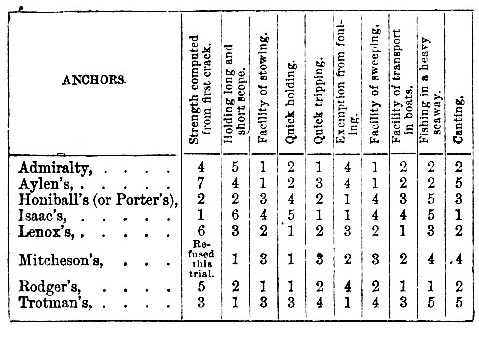1902 Encyclopedia > Anchor > Committee of 1852 on Anchors. Admiralty Anchor. Rodger's Anchor. Trotman's Anchor.
Anchor
(Part 3)
Committee of 1852 on Anchors. Admiralty Anchor. Rodger's Anchor. Trotman's Anchor.
Committee of 1852
Public attention having been directed to the subject of anchors by the specimens which were exhibited at the Exhibition of 1851, a committee was appointed by the Admiralty in the suceeding year to consider and report upon the qualifications of the various kinds. The committee determined the qualities it was desirable for an anchor to possess, and assigned numerical values to each. The following tables give the result of their labours, showing the number of marks obtained by each anchor under trial:
Table showing the relative order in which the several Anchors stand with regard to each of the properties essntial to a good Anchor -- the names arranged alphabetically.
Table showing the estimated numerical values of the several Anchors in regard to the properties considered essential to a good Anchor.
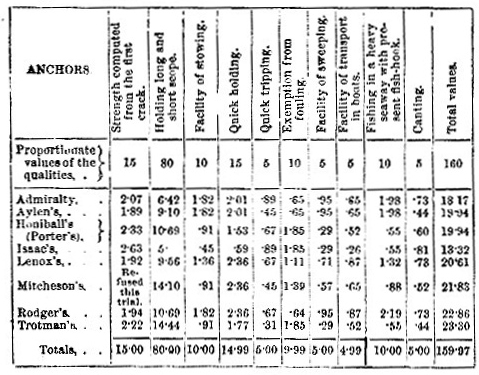
Note. This table only professes to show approximate values, and has no pretensions to mathematical accuracy or precision.
The following is a recapitulation of the order in which the anchors were ranked by the committee, together with their relative percentage of the inferiority to the Admiralty anchor, the value of which, as given in the foregoing table (18.17), was taken as the standard or unit:
The decisions of the committee have been much questioned, one of the objections being the qualities of strength and holding on, neither of which is one of any use without the other, were assigned such different values as 15 and 80; it has also been stated that the Admiralty anchor was treated unfairly, as one was taken promiscuously out of store for the trial, whereas the other competing anchors were made specially for it.
Admiralty Anchor
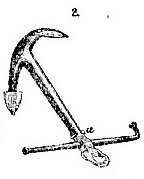
Fig. 2 -- Admiralty's (or Admiralty) Anchor
The Admiralty anchor (fig. 2) differs only from the ordinary anchor in having a nut, a, worked on the square, so that a wooden stock may be fitted temporarily if the iron stock is damaged, and that its proportions and form have been carefully considered and definitely fixed. Lenox's and Aylen's were modifications of the Admiralty anchor. Mitchenson's was of a difficult section to forge, and consequently expensive, and was withdrawn from the test of strength. Isaac's was a peculiar construction, and may be passed over as more curious than useful.
Rodger's Anchor
Rodger's anchor, placed second on the list, was one of Captain Rodger's, R.N., who for the last forty years has devoted considerable pains to the improvement of anchors.
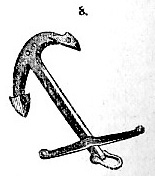
Fig. 3 -- Rodger's Anchor
Among his earlier inventions is an anchor with a hollow shank, to obtain greater strength with a given weight of iron; then an anchor without a palm, which he termed a "pickaxe anchor; " afterwards a "small-palmed" anchor; and by a patent taken in 1863, an "indented small-palmed anchor" (figs. 3 & 7).
The stock is of iron in large as well as small anchors, and is made with a mortice, to fit over the shank instead of passing through it. It is somewhat heavier than the stocks of other anchors; the arms shorter than usual in proportion to the length of the shank, and are of a wedge shape, varying in sharpness from the throat to the end of the palms; the back part of the arms is parallel from palm to palm; the palm is double concave on the front, and has a small border at the edge for the confining soil through which it is dragged; it also has a large indentation on the back for the same purpose and to save weight; the shank is rectangular at its junction with the arms, and square close to the collar for the stock; the crown is made longer than the usual, and has a large countersunk hole in its centre to save weight.
It is claimed for this anchor that the peculiar form of the palms and arms, with the hole in the crown, give it a great holding power, and that it will burry itself in the soil until the upper palm is beneath the surface, and consequently is not liable to be fouled by the cable.
Trotman's Anchor
Trotmans anchor (fig. 5), which obtained the highest place in the committee's estimation, was an improved Honiball's (Porter's). The stock is of iron, similar to the Admiralty anchor; the shank is of rectangular section, somewhat larger at the centre than the ends, and is made fork shaped at one end to receive the arms; the arms are in one piece, and are connected to the shank by a bolt passing through their centre. The peculiarity of the anchor is that the anchor arms pivot about this bolt, so that when it takes hold the upper fluke is brought in contact with the shank, thus reducing the height above ground, and rendering it almost impossible for the cable to get entangled round it, or, in other words, for the anchor to become foul.
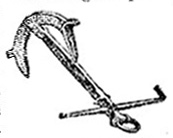
Of the anchors tested by the committee, Trotman's, Rodger's and the Admiralty find the most favour at the present time. Trotman's and the Admiralty have undergone no alteration, but Captain Rodgers has taken out two patents for improvments in his anchor since the committee reported.
Read the rest of this article:
Anchor - Table of Contents
|
